
May 2019
Program Is Key: Fight for Permanent Revolution
South Africa:
Socialist Revolutionary Workers
Party
Challenge to ANC Neo-Apartheid Regime
Critical Support to the SRWP in May 8 Elections!
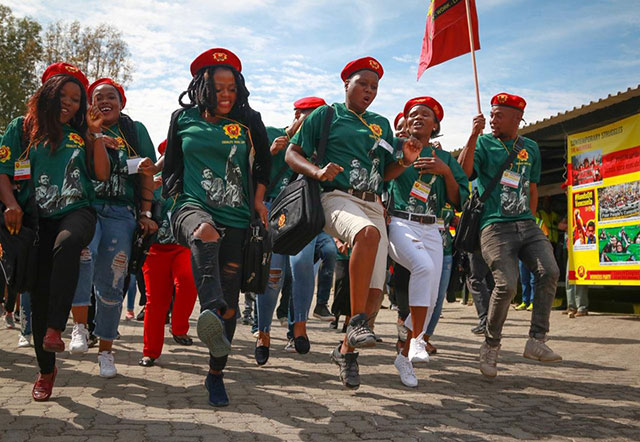
On the first day of the Launch Congress of the Socialist Revolutionary Workers Party. (Photo: SRWP / Twitter)
From April 4 to 6, the Socialist Revolutionary Workers Party (SRWP) of South Africa held its inaugural congress with a thousand delegates and guests in Ekurhuleni, outside Johannesburg. The party, which defines itself as communist and “Marxist-Leninist,” was initiated by the National Union of Metalworkers of South Africa (NUMSA), the largest and most militant trade union in the country. This is a major development in the South African class struggle, reflecting the continuing unrest and protest against the neo-apartheid regime following the horrendous 2012 police massacre of 34 striking miners at Marikana. It is, moreover, a direct challenge to the Tripartite Alliance – consisting of the African National Congress (ANC), South African Communist Party (SACP) and Congress of South African Trade Unions (COSATU) – a bourgeois “popular front” chaining workers to their capitalist rulers, which has governed the country since the end of formal white minority rule in 1994.
With national elections on May 8, the South African media have speculated about the impact of the new party on the voting. Could the scandal-ridden ANC led by President Cyril Ramaphosa fall below the 60% threshold, affecting its ability to govern as a patronage machine, or even lower as in 2016 local elections? Would the SRWP siphon off votes from the populist Economic Freedom Fighters (EFF) of Julius Malema, often falsely portrayed as “far left”? Whatever the arithmetic, bourgeois elections are inherently rigged against the working class, and particularly against any party that would act as a revolutionary opposition to capitalism. The preface to the SRWP 2019 Elections Manifesto on “Our Attitude to the 2019 Elections” (which begins with a quote from Lenin) states: “One of the most important elements of capitalism’s bourgeois system is an electoral system which gives the appearance of democracy while effectively ensuring power remains in the hands of the rich and powerful…. In real terms, elections are a weapon of suppression and oppression in the hands of the ruling class.”
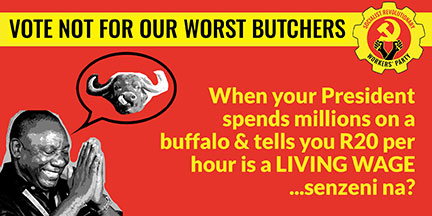 Election poster of the
Socialist Revolutionary Workers Party. Cyril Ramaphosa, the
former mine workers union leader who became a mine owner,
called for action against “criminal” strikers the day before
the Marikana Massacre in August 2012. That same year,
multimillionaire Ramaphosa bid R20 million (US$1.5 million)
for a prize buffalo for his breeding farm. In 2018 he decreed
a R20 minimum wage for workers. Senzeni na (what have we done)
was anti-apartheid anthem. (Photo
: SRWP / Facebook)
Election poster of the
Socialist Revolutionary Workers Party. Cyril Ramaphosa, the
former mine workers union leader who became a mine owner,
called for action against “criminal” strikers the day before
the Marikana Massacre in August 2012. That same year,
multimillionaire Ramaphosa bid R20 million (US$1.5 million)
for a prize buffalo for his breeding farm. In 2018 he decreed
a R20 minimum wage for workers. Senzeni na (what have we done)
was anti-apartheid anthem. (Photo
: SRWP / Facebook)Particularly given that it was launched barely a month before the looming vote, even those who recognize the formation of the SRWP as a major development that could shake up the political system of “post-apartheid” South Africa do not expect a big score in this round. Still, the stronghold of NUMSA in the key motor and metalworking industry and its presence in black townships surrounding the key cities can provide extra-parliamentary class power. Recent weeks have seen a mobilization of the new party’s militants in red shirts with hammer-and-sickle symbols at May Day marches by the South African Federation of Trade Unions (SAFTU) and its largest affiliate, NUMSA, in Polokwane, Durban and Mdanstsane, and at election rallies from the platinum mining center of Rustenburg in North West province to the Western Cape. And there are plenty of reasons why poor and working-class South Africans would vote for a communist party.
When the rigidly segregated white supremacist rule known as apartheid (“separateness” in Afrikaans) was formally ended in 1994 with the replacement of “whites only” voting by universal suffrage (“one person, one vote”), this was hailed around the globe as a victory. The hated passbook laws, impoverished urban townships and rural “Bantustans,” and pervasive police repression of the black African, coloured and Asian population were infamous the world over. The anti-apartheid struggle inspired the fight against black oppression in the United States, Brazil and elsewhere. But what replaced this vicious racist system was a black bourgeois government, led by the African National Congress, presiding over a capitalist economy that was still based on the superexploitation of black labor. Under this system of neo-apartheid wage slavery, while there have been some limited gains in housing and public services, since 2000 the per capita income of blacks and coloureds has fallen relative to whites.
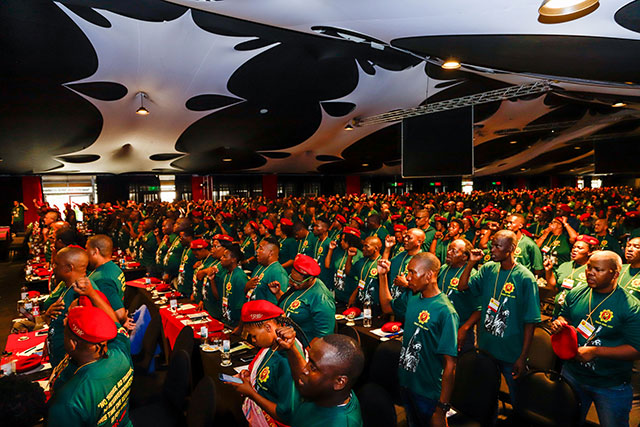
Delegates at the Congress of the Socialist Revolutionary Workers Party. (Photo: Rafael Stedile / People’s Dispatch)
Today, a quarter-century after the introduction of (bourgeois) “democracy,” official unemployment in South Africa stands at 37%, one of the highest rates in the world; for young people (under 25 years), over half (52%) are officially jobless. Out of a population of 55 million people, over 30 million are living in poverty, while one in four South Africans goes hungry every day. Today South Africa is the most unequal society on the planet, with 1% of the population owning 70% of the wealth. Spending on basic education has declined by 8% since the onset of the world capitalist economic crisis in 2008. A SAFTU survey declared, “Our Public Hospitals have become mortuaries!”1 Meanwhile, there have been escalating blackouts as the Eskom power authority cuts off electricity (“load-shedding”). And now the ANC government under Ramaphosa is threatening to make it all worse by carving up Eskom and preparing privatization schemes affecting education, water, communications and healthcare.
A major issue in South Africa over the past year has been the land question, namely the theft of African land by the Boer (farmer) settlers dating back to the Native Lands Act of 1913. This colonial law banned black Africans from owning, buying or renting land in 93% of South Africa even though they make up more than four-fifths of the population. A key purpose was to create a labor force of landless agricultural laborers and to force others off the land and into the mines and urban centers. Although the ANC’s Freedom Charter said that “Land shall be shared among those who work it,” that has not happened, at all. A government Land Audit Report (November 2017) shows that today white farmers own 72% of privately held land, and when you add land owned by companies, trusts and community based organizations (also almost entirely white), this totals 88% – essentially the same percentage as in 1994 – while Africans own barely 1.5% of the land (Coloureds and Indians own 7%).
With blacks still jam-packed in urban townships, mostly living in shacks, land hunger is explosive. Malema’s EFF has made the land question the focal point of its election campaign, vowing to push through and implement an amendment to Section 25 of the South African’s Constitution’s Bill of Rights to allow expropriation without compensation of this stolen land. (Parliament last year agreed that there should be such an amendment but failed to enact it, or even to present a draft.) Ex-president Jacob Zuma, who was forced to resign last year in a power play by Ramaphosa, has been trying to claw his way back by emphasizing his support for land expropriation, hoping to win popular support and possibly a post-election alliance with the EFF. Ramaphosa claims to support the demand, yet out of the other side of his mouth he assures international capitalist investors at the World Economic Forum at Davos, Switzerland, in January that “We are not going to allow land grabs in South Africa.”
Meanwhile, police have been arresting impoverished blacks who have invaded land held by white farmers, notably in the Stellenbosch wine-growing region, and a court just declared the Black First Land First party’s slogan, “Land or Death” to be a “hate crime”! Wealthy farmers are screaming bloody murder, and U.S. president Donald Trump, the white supremacist in the White House, has trumpeted the myth of Afrikaner ultra-rightists that whites are being forced off “their” land by the government and targeted for “large-scale killing.” In reality, however land reform legislation is formulated, there will only be at most some land seizures. A wholesale overturn of landownership is impossible short of a revolution, which all of these bourgeois politicians would bitterly oppose. The SRWP’s Election Manifesto, in contrast, declares: “We will abolish private property ownership and inheritance rights, nationalising and collectivising the land for common use under the control of a workers state.”
The Socialist Revolutionary Workers Party’s “first act as a Socialist state will be to abolish private property ownership,” said its chairperson Irvin Jim at a May 4 election rally. While wealthy, mainly white, capitalists lord it over South Africa, the working class which creates that wealth lives in “absolute filth and poverty,” eking out a precarious existence in townships like Alexandra in Johannesburg and Khayelitsha near Cape Town. In addition to land, the SRWP Election Manifesto highlights measures for equality, calling to “ensure that domestic work no longer be a woman’s burden, by socialising it through public childcare centres, state-funded domestic services and public eateries.” The Manifesto also calls to “ensure that full citizenship rights are granted to all the working class, especially to all immigrants.” And it declares that “SRWP shall nationalise all strategic industries, particularly the mines, the land and commercial farms, the banks, the big factories and the big businesses.”
This would take a socialist revolution, which won’t be enacted by a bourgeois parliament. So what is the purpose of participating in the electoral shell game? A 12-point SRWP election video declares:
“9. The election process itself must be conducted NOT as a drive for the maximization of parliamentary seats but as a MOBILISATION OF THE MASSES around BUILDING CONSCIOUSNESS of WORKING CLASS REVOLUTION.
“10. Our task is to expose parliament as being permanently captured by the IMPERIALIST-CAPITALIST CLASS, while PROMOTING INDEPENDENT, DEMOCRATIC ORGANS OF WORKERS’ POWER OUTSIDE OF IT….
“12. The revolutionary party enters parliament not to function within it as an integral part of the parliamentary system but to TAKE ACTION in Parliament that helps to smash the bourgeois state machine and parliament itself.”
Needless to say, it is quite unusual in this day and age for a party claiming some 20,000+ members to talk of smashing the capitalist state machine while running candidates in bourgeois elections. Media pundits characterize the SWRP as “a blast from the ideological past,” but some at least recognize that “Many workers in this country feel betrayed by the ANC and its alliance partner, Cosatu, whom they believed have ‘sold out’ the struggle for socialism” (“New workers’ party could shake up elections,” The Citizen, 20 December 2018). While bourgeois politicians and reformist pseudo-socialists the world over have peddled the lie of a supposed “death of communism” following the counterrevolution that brought down the bureaucratically degenerated Soviet Union and East European deformed workers states, South African workers “never got the memo.” As they rose up against apartheid, millions of black toilers believed they were fighting for socialism and to smash capitalism. Many still do, now more than ever.
For Revolutionary Opposition to the
Popular-Front
ANC/SACP/COSATU Tripartite Alliance
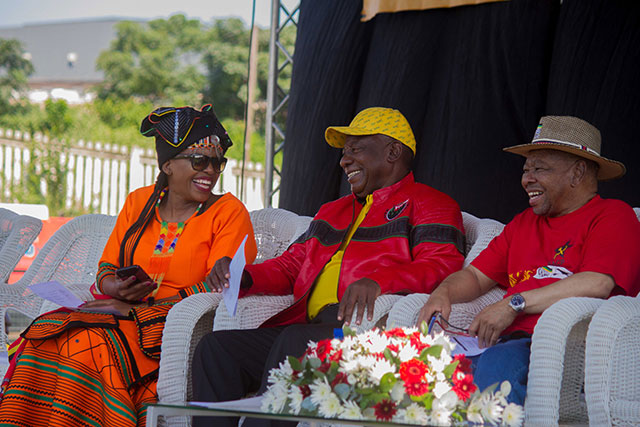
May Day celebration in Durban. From left: COSATU president Zingiswa Losi, South African president Cyril Ramaphosa and SACP leader Blade Nizmande, 1 May 2019 (Photo: Mlungisi Mbele / New Frame)
The current election campaign in South Africa has focused on the corruption of political elites. This was the issue that was used to topple Zuma with media campaigns, court hearings and finally a palace coup inside the African National Congress. In December 2017, Cyril Ramaphosa, the former mine workers union leader who became a capitalist mine owner and the richest black African in South Africa (net worth in 2018, according to Forbes magazine, US$450 million) narrowly defeated the ex-wife of state president Zuma (net worth, US$20 million) for the presidency of the ANC. Ramaphosa won because one of Zuma’s corrupt cronies flipped his vote at the last moment. Zuma had become anathema to the white capitalist establishment because of his deals with the Gupta brothers, upstart Indian immigrants who made a fortune by milking state enterprises through their agents in what became known as “state capture.” Yet these bosses have eagerly bought off ANC politicians ever since it came to office.
Ramaphosa got his millions from the same source, Black Economic Empowerment (BEE) schemes under which white capitalists would take on non-white partners. As ANC secretary-general he led negotiations with the National Party government that led to the 1994 elections and the formal end of apartheid under President Nelson Mandela. After Ramaphosa lost to Thabo Mbeki for the presidential succession in 1997, Mandela’s doctor suggested him as deputy chairman of New Africa Investments, which used worker pension funds to buy up companies. He later set up his own holding company, Shanduka, which became a BEE partner with Swiss-based Glencore in coal mining deals and then majority shareholder in the Lonrho platinum mining conglomerate. In the 2012 Lonrho miners’ strike, Ramaphosa, the former Mineworkers leader become mine boss, sent an e-mail calling the protesters “criminal” and calling for “concomitant action.” The next day, police shot dead 34 miners at Marikana.
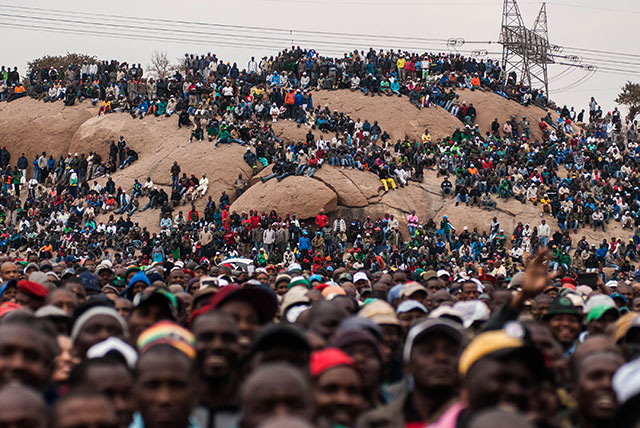
Miners commemorate second anniversary of the Marikana massacre in Rustenburg, 16 August 2014.
(Photo: Waldo Swiegers / Gallo Images / Sunday Times)
One of the main slogans of the SRWP in these elections is “vote not for our main butchers” – that is, Ramaphosa. Whether by looting state coffers or by receiving shares from top capitalists, the essence of the ANC-governed neo-apartheid system has been to spawn a layer of black capitalist junior partners in the superexploitation of black workers. A key role in this was played by the South African Communist Party, through its leadership of the ANC, in the guise of a “National Democratic Revolution.” According to the SACP program of “two-stage revolution,” inherited from Stalin, the NDR would be the first, bourgeois-democratic stage in which the “communists” would serve as front men for capitalist rule. Of course, the supposed “socialist” stage of this Stalinist dogma has never occurred, neither in South Africa nor anywhere else. Instead, the real second stage is the bloody repression and massacre of the workers, as occurred in China in 1927, Spain in 1937, Chile in 1972 and South Africa in 2012.
The Stalinist schema is directly counterposed to – and a betrayal of – the program of the Bolshevik Revolution of October 1917, which Lenin laid out in his famous April Theses calling for “all power to the Soviets” – that is, the fight for proletarian revolution. (Stalin had instead given conditional support to the bourgeois Provisional Government.) Since the mid-1930s, the political vehicle for this betrayal has been the “popular front,” in which the workers movement is chained to a section of the bourgeoisie. This class-collaborationist alliance serves as a roadblock to revolution, on the grounds that any socialist measure would mean breaking with the bourgeois “allies.” The embodiment of this anti-revolutionary strategy in South Africa is the Tripartite Alliance of the ANC, SACP and COSATU labor federation. The significance of the founding of the Socialist Revolutionary Workers Party is that it poses a break from the nationalist popular front that has governed South Africa for the past quarter century.
That alliance was presided over by Nelson Mandela, who as the ANC declared in its obituary had been a member of the South African Communist Party, and at the time of his arrest in 1962 was a member of the SACP Central Committee. The program of this alliance is the ANC’s Freedom Charter (1955), which contrary to popular-front leftists and anti-communist rightists is not some kind of crypto-socialist, anti-capitalist document. On the contrary, with its vague talk of “socialization” and transferring ownership of mineral wealth, banks and monopoly industry to “the people,” the Freedom Charter was intended, as Mandela himself wrote the next year, to promote “the development of a prosperous Non-European bourgeois class.” This is precisely what has happened under the ANC/SACP/COSATU regime. As Mandela remarked in his autobiography, Long Walk to Freedom (1994): “The cynical have always suggested that the communists were using us, but who is to say that we were not using them?”
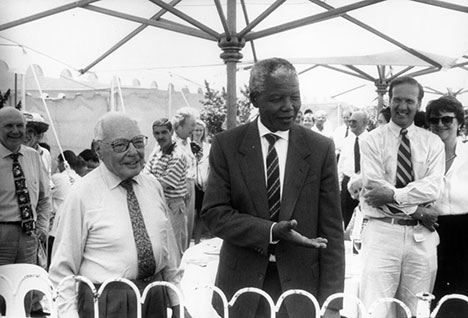 The ANC/COSATU/SACP Tripartite
Alliance that has presided over neo-apartheid South Africa has
a fourth, silent partner: the Randlords who have promoted
black capitalist leaders. At right: Nelson Mandela with Anglo
American chief Harry Oppenheimer in February 1994.
The ANC/COSATU/SACP Tripartite
Alliance that has presided over neo-apartheid South Africa has
a fourth, silent partner: the Randlords who have promoted
black capitalist leaders. At right: Nelson Mandela with Anglo
American chief Harry Oppenheimer in February 1994. (Photo : Gallo Images / Avusa)
In reality, there is a fourth, silent partner in this “alliance,” namely the mining magnates of the Witwatersrand, including Harry Oppenheimer of Anglo-American (who gave money to Mandela), Clive Menell of the rival Anglo-Vaal mining group, and Roland Rowland of Lonrho, a secret financiers of the ANC who lent his jet to ANC leader Oliver Tambo and bought a mansion in Sandhurst, Sandton for Ramaphosa. The key moment in South Africa when the ANC/SACP/COSATU popular front with the Randlords that led to the Marikana massacre could have been broken was the period of negotiations with the apartheid masters during 1991-94. The Stalinists had given up all pretense of revolution following the counterrevolution in the Soviet Union and the East European deformed workers states. Yet NUMSA general-secretary Moses Mayekiso, reflecting discontent in the ranks, called at the union’s congress in July 1993 for independence from an ANC government while the congress called for:
“new forms of organization that will unify working class organisations, and parties that will take forward a programme to implement socialism. This could take the form of a working-class party.”
–quoted in Kally Forrest, Metal That Will Not Bend: National Union of Metalworkers of South Africa, 1980-1995 (Witts University Press, 2011)
But after finding no support for its opposition to the Tripartite Alliance and being rebuffed in its calls for nationalization and defense of workers rights at a COSATU special conference that September, the NUMSA leadership essentially dropped its objections. Its opposition harked back to the “workerist” stance of the original MAWU (Metal and Allied Workers Union) in the 1970s, wanting a more pro-labor content to an alliance and looking to an all-inclusive party like the British Labour Party rather than a Leninist party of the revolutionary proletarian vanguard. NUMSA even wrote early drafts of a Keynesian capitalist Reconstruction and Development Programme (RDP), which was then turned into the “neo-liberal” program of the Mandela government. Mayekiso and NUMSA’s hesitant semi-opposition did not provide a road forward, which would have required a sharp break with the Tripartite Alliance and a working-class opposition to Mandela and the bourgeois ANC in the 1994 election.
Certainly that would have been distinctly unpopular amidst the euphoria over the end of formal apartheid and dreams of peace and harmony as Mandela and De Klerk held hands at the May 1994 inauguration. Most of the South African left then called for a vote for the ANC. However, the Workers Organization for Socialist Action (WOSA) led by Neville Alexander put forward a Workers List Party (WLP) which “reject[ed] the idea of a Government of National Unity that includes the racists.” The International Communist League, which then stood on the program of revolutionary Trotskyism, called for critical support to the left-reformist WLP as drawing a class line against the bourgeois nationalist ANC. But rather than WOSA’s call for an amorphous “mass workers party,” we emphasized then that what was needed is “a Bolshevik-Leninist party forged on the program of permanent revolution” (Workers Vanguard No. 599, 29 April 1994). The same is true today.
Critical Support to the SRWP
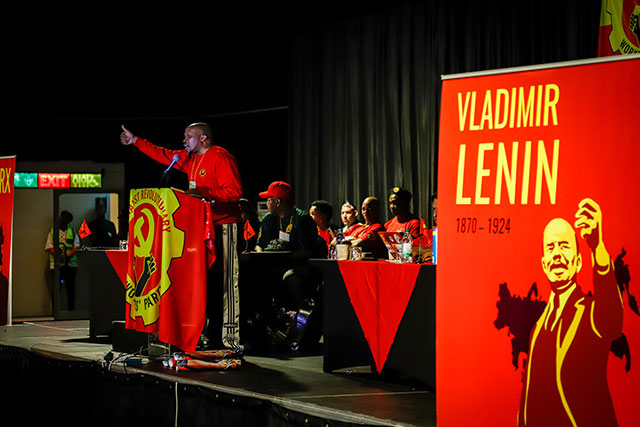
Speaking at Socialist Revolutionary Workers Party inaugural congress. (Photo: Rafael Stedile / People’s Dispatch)
The introduction to the 2019 Elections Manifesto of the Socialist Revolutionary Workers Party declares it is “guided by Marxism-Leninism.” The SRWP seeks to “educate, agitate, mobilise and organize the working class” for the “historic mission to defeat imperialism and capitalism and to establish a Socialist South Africa, Africa and World, as a prelude to advancing to a truly free and classless society: to a Communist South Africa, Africa and Communist World!” These principles are correct and urgent. The burning issue is how to get there. The key is the fight for a revolutionary program, and central to that, as always, is the question of the state.
During the SRWP’s Launch Congress, it published online brief quotes from various documents and speeches. “The short term task of Socialists is to ensure the direction preparation of the political and technical aspects of the working class uprising,” read an excerpt from the party’s draft manifesto. NUMSA president Andrew Chirwa said the union is firmly behind the SRWP: “This is not a party for reform. This is a party for communists. We are serious about the Revolution. We are a party for SOCIALISM and nothing else.” SRWP national convenor and NUMSA secretary-general Irvin Jim, speaking from a podium set between panels depicting Karl Marx and Vladimir Lenin, declared: “The ultimate mission is to overthrow capitalism as a system and replace it with the dictatorship of the proletariat for the struggle for SOCIALISM.”
At the same time there were delegations from Brazil of the PT (Workers Party), which for 13 years led a bourgeois popular-front government just as corrupt as the ANC’s, which failed to carry out even a minimal land reform and presided over the capitalist state, beefing up its repressive forces against protests by the poor and working people and implementing anti-worker policies in alliance with right-wing bourgeois parties. Also present were guests from the PT-allied MST (Landless Workers Movement) and from the PSOL (Party of Socialism and Freedom), which voted for the PT in the decisive round of the October 2018 elections. The demonstration by Congress delegates and guests demanding freedom for imprisoned PT leader Luis Ignácio Lula da Silva was an act of internationalism. But the prominence given to the ultra-reformist popular-frontist Partido dos Trabalhadores and its allies undercuts the SRWP’s call for a workers state that would nationalize the land and big business.
Another of the quotes from the Congress read: “Capitalism has failed! We've tried it and our people are still jobless and homeless.” This goes along with various statements to the press saying that NUMSA “decided to form the workers’ party after realising that more than two decades after freedom and democracy, the capitalist system had intensified the suffering of the working class” (The Citizen, 20 December 2018). Others cited the shock of the Marikana massacre leading to NUMSA’s decision at its 2013 special congress to call for the formation of a revolutionary socialist workers party. This seems a frank and accurate description of the lead-up to the birth of the SRWP, and a reflection of the thoughts of many South African workers today. At the same time, it speaks of an empirical reaction to the experience of South African workers after 25 years of black capitalist government under the ANC. What’s needed is a theoretical understanding and programmatic expression of that belated recognition.
The launching of a self-proclaimed communist party based on the workers movement with some tens of thousands of working-class members and calling to smash the capitalist state is a huge development. The SRWP slogans and election platform denouncing “capitalist democracy in post-apartheid South Africa” as “a system where once in five years workers are asked to vote for one capitalist party or another” place it well to the left of most reformist pseudo-socialist, pseudo-communist and even pseudo-Trotskyist groups. We call for critical support in the May 8 South African elections to the Socialist Revolutionary Workers Party, drawing a class line against the capitalist ANC and other bourgeois parties, including the EFF, and potentially opening the way to a breakthrough in the struggle for socialist revolution in South Africa and the whole of the African continent.
But our call must be for a critical vote for the SRWP, as the concrete politics of the newly formed party are far from fully formed. While it opposes the devastation that the capitalist ANC has brought upon poor and working people, and calls for a communist South Africa and African continent rather than a two-stage revolution, it has not explicitly broken with the Stalinist heritage, from which many of its cadres come, nor with its pretense of representing “Marxism-Leninism.” Mao Zedong and Fidel Castro are quoted favorably. And while the SRWP speaks of a “workers state” and “socialist state,” its official documents do not explain how this would come about or call explicitly for socialist revolution. This is important in a context where both the Stalinist SACP and sundry social democrats talk of “socialism” as resulting from an electoral victory and based on the existing capitalist state.
There has clearly been considerable discussion of the question of the state in the course of the formation of the SRWP, but the outcome is uncertain. A “Draft Manifesto of the Socialist Revolutionary Workers’ Party,” amended as of 16 February 2019, quotes extensively from Lenin’s State and Revolution (1917), the theoretical preparation for the October Revolution. It states:
“parliament is a form of capitalist class rule and … the demands of the working class shall never be achieved through parliament. The end of the apartheid regime came through the action of the revolutionary masses. Workers need to set up their own organs of representation, a workers’ Soviets/Councils and a workers government. The bourgeois parliament must be disbanded. We stand for the dictatorship of the working class in power.”
However, a subsequent amended version of the Manifesto presented to the April Launch Congress dropped these references. In addition, where the February version called for such measures as “mineral wealth, mines, banks, strategic and monopoly industry shall be nationalised and placed under workers control and management by the Socialist government,” and “nationalisation of the banks, mines, without compensation,” the April version makes no mention of nationalisation, workers control, workers councils or a workers government. Clearly there has been a push to “moderate” the Manifesto.
Particularly significant is the reference in both version to “popular election” of “police bodies” and “security services” of a “Socialist South Africa,” which are supposed to be “helpers, protectors and defenders of the people.” But, whereas the earlier draft calls for “armed workers self-defence that is directly and immediately accountable to the workers councils,” saying that “the armed organs of the capitalist state must be disbanded,” all this is gone in the version presented to the Congress. This implies that without a revolution smashing the capitalist state apparatus there could be some kind of reform (“popular election” of police) that would turn these repressive organs of capital into “defenders of the people.” This is a particularly deadly illusion, as the Marikana massacre underlined. The SACP has both led the POPCRU police and prison guards “union” and commanded police and security forces, and the SAFTU includes a police “union.” Revolutionary Marxists call instead for cops out of the unions.
For a Leninist-Trotskyist Party to Fight for Permanent Revolution in South Africa
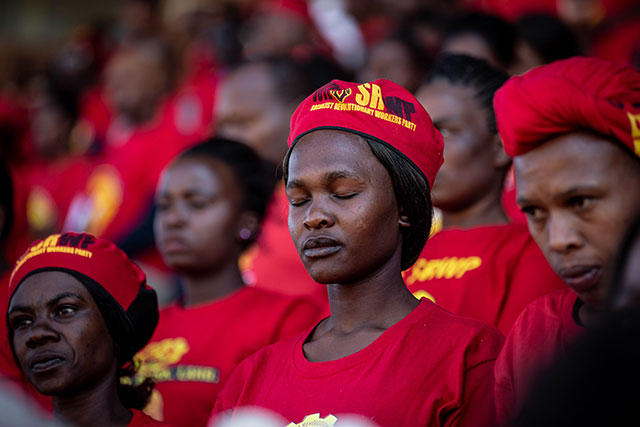
SRWP supporters observe moment of silence for fallen comrades at SAFTU rally in Polokwane, Limpopo province, 1 May 2019. (Photo: Gulshan Khan / New Frame)
Such issues require sharp political debate, for they go to the heart of the struggle for socialist revolution in South Africa. The slightest concession to Stalinist and social-democratic reformism here would doom the struggle for genuine communism based on the program of Marx, Lenin and Trotsky. The fact that these questions are being debated in the newly formed party underscores the importance of its appearance. It’s significant, therefore, that the main group in South Africa claiming to represent Trotskyism, the Workers and Socialist Party (WASP), affiliated with the Committee for a Workers International (CWI) historically led by Peter Taaffe, is far to the right of the SRWP, criticizing it from a purely social-democratic standpoint. Thus the CWI considers cops to be “workers in uniform” and organizes “unions” of prison guards in Britain, as we have noted in denouncing this fatal illusion.2
The WASP traces its origins back to the “Marxist Workers Tendency” of the ANC. The very idea of a “Marxist” tendency of a capitalist party is a frontal attack on Leninism and Trotskyism, negating the class line. Yet the Taaffeites are repeat offenders, repeating this betrayal from Pakistan and South Africa to Mexico and Venezuela. Naturally they called for a vote to put the ANC in office in 1994, and thus bear responsibility for its subsequent anti-worker policies. Rather than calling for a workers party based on the program of Marx and Lenin, fighting for the dictatorship of the proletariat and a communist South Africa, the WASP calls (“Potential for working class unity in new mass party,” Izwi Labasebenzi, November 2018) to build a “new mass party” around the struggle for a monthly minimum wage of R12,500 (a little under US$900). This is like calling for a workers party in the United States on a program for “$15 Now.”
In a recent statement, “How should workers use their vote on 8 May?” (27 April), the WASP was even more explicit, accusing the SRWP of being insufficiently electoralist (“a light-minded attitude towards using parliament for mass mobilization”) because was launched only a month before the elections. Doing their electoral math, these fake Trotskyists argue that, simply based on the NUMSA membership, it “could have secured at least six seats for working class MPs with a proper campaign.” Talk about parliamentary cretinism! While reluctantly calling for a vote for the SRWP, the WASP urges it to dissolve into a “mass workers party” that “can unite the broadest possible layers of the working class,” based on the July 2018 Working Class Summit called by the SAFTU under Zwelinzima Vavi. Far from calling to smash the capitalist state, the WASP social democrats dream of administering it, as their British comrades did in the 1980s until the Labour Party tops gave them the boot.
The SRWP grew out of the December 2013 special congress of NUMSA which codified its break with the ANC/SACP/COSATU Tripartite Alliance that it rightly held responsible for the Marikana massacre. At the time, we noted that this “promises to be an earthquake in South African politics” (“South Africa: Workers Slam ANC Neo-Apartheid Regime,” The Internationalist No. 36, January-February 2014). Nevertheless, we pointed out that NUMSA leaders still upheld the ANC’s Freedom Charter and the Stalinist program of a “New Democratic Revolution,” although sometimes giving it a left twist. We also underscored the ambiguity of what was meant by socialism. As recently as 2016, NUMSA defended its earlier “tactical support” to Zuma against Mbeki within the ANC. On these issues there has been a notable evolution, as the documents of the SRWP no longer praise the Freedom Charter or call to push the ANC to the left nor do they mention the NDR, instead calling for the dictatorship of the proletariat. However, many ambiguities and reformist conceptions remain.
We noted then that “NUMSA documents are sharply critical of how the Alliance has turned out, but they do not oppose such a class-collaborationist political coalition on principle,” rejecting the very basis of this nationalist popular front. Instead, while noting that the union had backed the ANC from 1994 up until its 2013 break, SRWP spokesman have said that policy had become “outdated.” This leaves the door open to supporting a less cravenly anti-worker alliance with bourgeois forces, such as the EFF. Beyond such key issues of policy and strategy, NUMSA’s trade-union practice is often more militant than other unions – and certainly than the strikebreaking of the National Union Mineworkers and other COSATU affiliates – but firmly within the capitalist framework. NUMSA still has an investment company, whose CEO has been linked to the Zuma faction of the ANC, and while criticizing Ramaphosa’s 2018 anti-union labor relations law, it has generally adhered to the restrictions on strikes.
A genuinely revolutionary workers party cannot be bound by capitalist legality as it fights for transitional demands posing the need for socialist revolution. In the face of the escalating blackouts the SRWP calls to oppose Ramaphosa’s plans to dismember and ultimately privatize Eskom. However, a communist leadership would go further, occupying the power plants and imposing workers control of the electrical grid, rooting out the endemic corruption and acting to provide reliable energy to working-class districts. It would act as a tribune of the people, not only criticizing reactionary attitudes toward immigrant workers but mobilizing to prevent pogroms and anti-immigrant repression. While the new party rightly appeals to working people from all ethnic groups, in the South African context, where more than four-fifths of the population is African and continues to be subject to deep-seated racial oppression, a communist vanguard cannot be color-blind and should fight for a black-centered workers government.
A quarter century of neo-apartheid superexploitation under a black capitalist government is excruciating proof of the bankruptcy of the Stalinist/social-democratic reformist policies of popular-front class collaboration and “two-stage” revolution. The conditions of impoverished township dwellers, industrial and mine workers and landless agricultural laborers make clear that only a party based on Leon Trotsky’s perspective of permanent revolution can show a way out of the hell that South Africa’s toilers have been condemned to. Co-leader together with Lenin of the 1917 October Revolution, Trotsky held that in semi-feudal and late-developing capitalist countries like tsarist Russia – or apartheid South Africa – even basic democratic rights cannot be won except by the working class taking power, establishing its own class rule in a workers government that overthrows capitalism and extends the socialist revolution internationally.
The appearance of an explicitly communist party based on militant sections of the South African proletariat has tremendous potential, which could shake the entire continent as masses of working people are bringing down entrenched governments in Sudan and Algeria, and send shock waves into Europe and around the world. The decades-long struggle against apartheid slavery electrified fighters and defenders of the oppressed across the planet. The struggle against the neo-apartheid regime could do so again. But that can only occur under the leadership of a revolutionary communist workers party steeled in the political battle against all forms of reformism on the basis of the genuine Bolshevism, in a reforged Fourth International, world party of socialist revolution. ■
